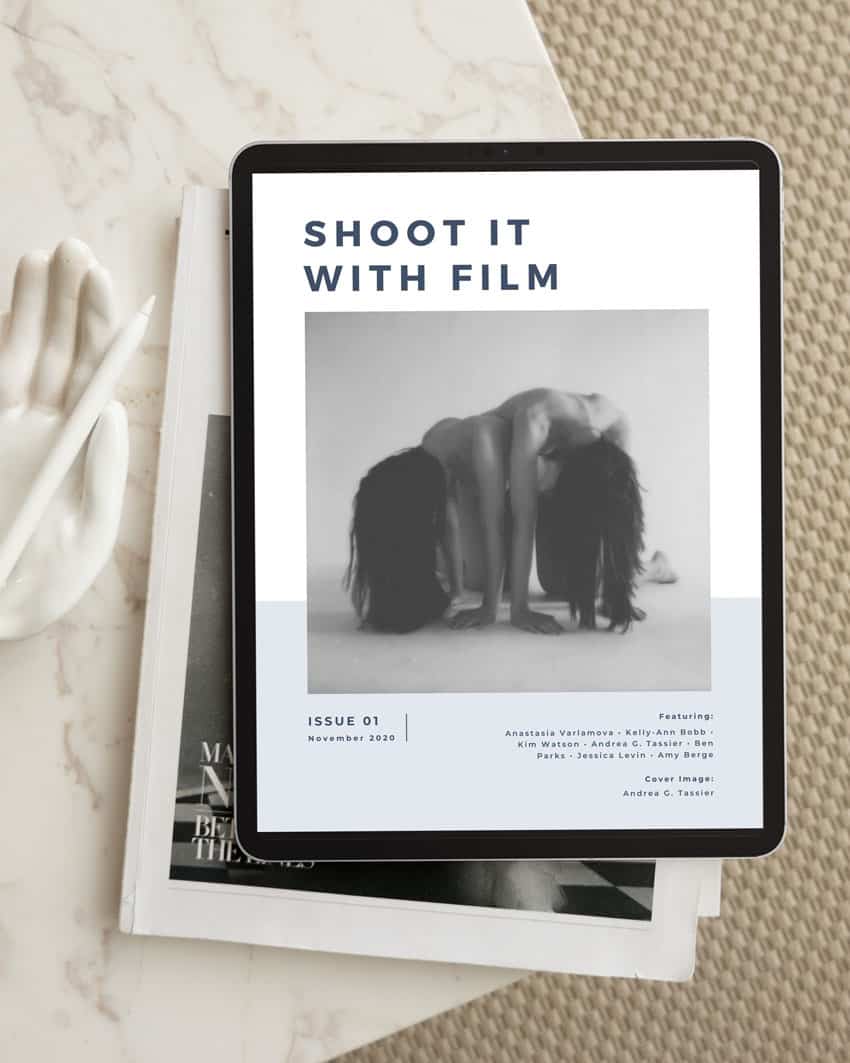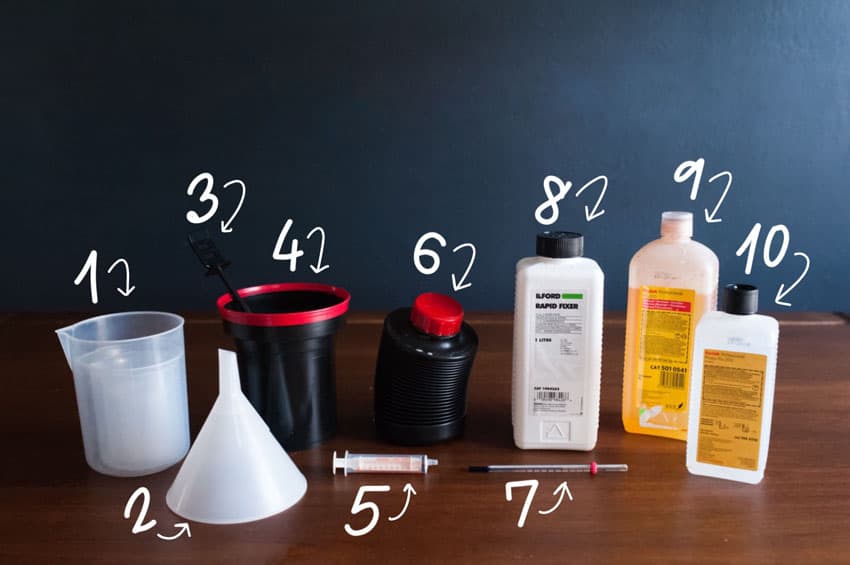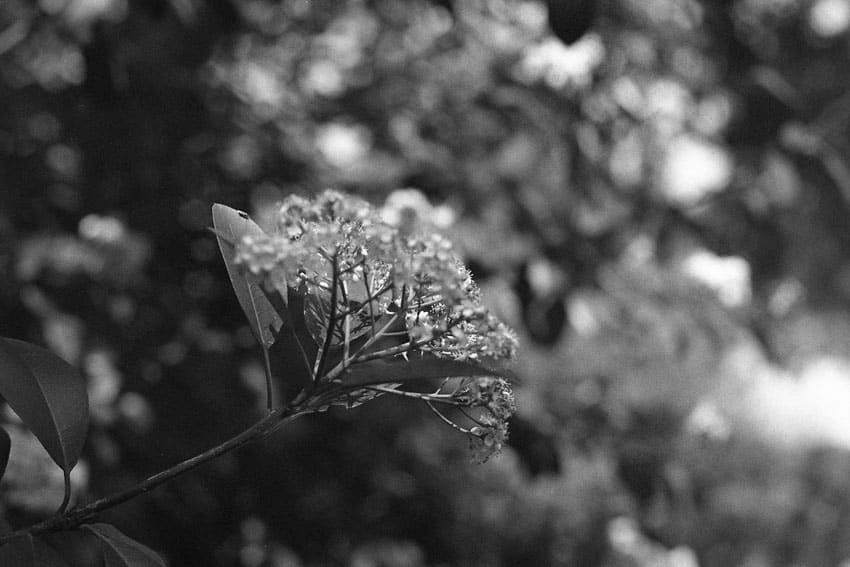
Written by Taylor Blanchard
I learned how to print in a community darkroom and loved it when someone who hadn’t printed in years, or even decades, would visit. Their first comment, always, was, “Oh, I remember this smell.”
What causes that unique and unforgettable smell? When the trays are rocked every so often, off-gasses from the chemistry build in the room, which gives the darkroom that signature smell.
As a general rule, developing your own negatives and printing in the darkroom is generally safe. But, we’re using chemical compounds that come with health and safety concerns, especially in their concentrated or powder state.
Most of the chemistry we use can be toxic by inhalation, ingestion, or skin contact. While film photography chemicals are well-studied, what’s less certain is how their effects may compound over time, or how they may affect humans when used together.
We’ve already shared tips about how we can better protect the environment when developing film. Here are four techniques and tips to better protect us and those around us when we develop film or make prints in the darkroom.

1. Protect Your Eyes, Lungs, and Skin
Powder forms of all chemicals can cause damage to mucous membranes, so it’s best to protect your nasal passages, eyes, and skin.
Powders should be mixed in a well-ventilated area (or outside if you have a safe place). When mixing any chemistry, liquid or powder, the safest approach is to wear a high-quality ventilator mask. If you don’t have that kind of mask, I recommend a KN95 mask. As a last resort, any mask will offer some level of protection.
The same advice applies to protecting your eyes. Wear high-quality goggles that wrap around, covering the entire eye area.
Wear a pair of gloves when mixing chemistry, and especially when mixing color chemistry. I always wear gloves during the entire C-41 process because the warm chemistry seems more likely to leach out of my Patterson tank (even when appropriately “burped”).
To protect your skin, use tongs when moving paper from one bath of chemistry to the next.
I always recommend wearing an apron to protect your clothes from darkroom chemistry, and if possible, wear longer pants and sleeves.
Finally, when mixing chemicals, always add acid to water, and not the other way around.



2. Vent Your Space
Most darkrooms have a consistent, shared feature: poor ventilation. If you’re able to build a darkroom from scratch, or if you have a room where you can add a vent, do it! HVAC vents in the room bring air in, so you need to add something that moves air out.
You can easily find darkroom fans for sale, which vent the space while keeping light out; however, any exhaust vent will work – it doesn’t have to be darkroom-specific. If you’re able, place the vent close to where you set up the darkroom trays.
Or, open a door or window. For paper, we put in a lot of effort to ensure that a darkroom is light tight, which usually means air isn’t moving. If you print at night and can’t add a vent, you may be able to open a window or door to circulate fresh air into your space.*
This depends on the size of your darkroom and where any windows or doors are located in relation to your workspace. You can add black foam core boards to prevent light from entering your workspace, as light is not very good at traversing corners.
If you’re developing negatives in a light-tight tank, you may inhale some of the fumes when pouring chemistry in and out of the tank. Why not open a door or window and turn on a fan for air circulation? I always follow that rule with color film development. Of course when it comes to drying negatives, I turn the fan off to prevent dust from blowing around.
(*I have to give credit to Steve Anchell’s The Darkroom Cookbook for that idea.)


3. Use an Eco-Line of Chemistry
In this past article, we reviewed alternatives for developing negatives; there are also paper developers, stop, and fixer chemicals that are low toxicity and more eco-friendly. You can also use the eco-friendly stop and fixer for developing negatives.
Look for chemicals that are sold as low toxicity and odorless or odor-free. These chemicals should use compounds that are safer for humans. Again, in their concentrated states, they are still of concern, but overall should be safer to be around.
ADOX makes a line of Eco chemicals, available in the EU and UK, but availability in the U.S. is quite spotty.
Canada’s Flic Film sells an environmentally friendly paper developer, Phenatal Green, a low odor stop bath, and an “allergen free” fixer. Flic Film also makes a C-41 “Eco” kit that uses less chemistry than other brands, but the chemicals themselves are unchanged and still toxic. I applaud their efforts though, as one of my primary tips for eco-friendly developing was using less chemistry/only the chemistry you need. These are next on my list to try!
I started using the Legacy Pro Eco-Pro line of paper developer, stop, and fixer, and I’ve also tested the stop and fixer with black and white negatives.
I’ve been happy with the results of the Eco-Pro line and will continue to stock my darkroom with one of these alternatives. I was a bit skeptical with the paper developer, but since using it, my prints have had good contrast and tonal range, and the development times are similar to other paper developers.
One tip: if printing fiber paper, follow the ratios on the bottle as you’ll need a stronger ratio. You will still notice a bit of the “darkroom smell,” but it’s much milder.
My hope is that more and more of these products will be available in the coming years and be more widely available.



4. Label Your Chemistry and Store It Safely
Many of the chemicals we use in the darkroom would be toxic if ingested and should be stored safely – away from pets and children.
While it’s very unlikely a pet or child would eat or drink any of those chemicals, even a small amount of these chemicals could be toxic. I keep my darkroom chemicals away from household products and other storage bottles.
It’s also best to keep food and beverage out of the darkroom, or ensure beverages are always capped.
Label all of your mixed chemistry bottles clearly, so you don’t inadvertently mix chemicals.
Finally, when you first get your chemicals, read the labels and inserts that come with the chemicals, so you know the procedures for dealing with ingestion, inhalation, or skin or eye contact.


Conclusion
Much of the online chatter about exposure to darkroom chemistry is anecdotal, along the lines of “I have printed in a darkroom for so many years” or “I work in a lab” as a reason you don’t have to take precautions. I’ve also heard from people who have sinus issues or headaches after spending time in the darkroom. While I think these processes are generally safe, and they have been practiced by many people for many, many years, it’s impossible to say with absolute certainty that it’s a harmless process.
It’s up to each of us individually what steps we want to take to protect ourselves, or not.
What practices do you follow? Like me, do you have intentions to wear a mask when mixing, and sometimes forget?

Thank you so much, Taylor! Taylor is a regular contributor here at Shoot It With Film, and you can check out her other articles here, such as Eco-Friendly Tips for Developing Your Own Film and 7 Lesser-known Color Film Stocks Worth Trying.
You can also check out more of Taylor’s work on Instagram.
Leave your questions about these eco-friendly tips for developing your own film below in the comments!








Blog Comments
dj
November 1, 2024 at 11:34 am
great read!
nice mix of warnings & encouragement!
user be careful
cheers,
-dj
Taylor Blanchard
November 3, 2024 at 1:24 pm
Thank you for reading, DJ! Yes, I certainly didn’t want to scare anyone off but also wanted to share safety precautions. Take care,
Taylor